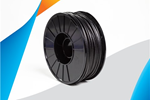Braskem demonstrates PP solutions using Weav3D composite lattice technology
Partnership combines Braskem’s polypropylene sheets with Weav3D Rebar for Plastics technology to address new structural, automotive applications requiring high-strength, lightweight material solutions.
Beltline stiffener for automotive produced using Braskem and Weav3D technologies. Photo Credit: Braskem
Polyolefins and biopolymers producer (Philadelphia, Pa., U.S.) announces a demonstration of the company’s polypropylene (PP) polymer in combination with Weav3D Inc. (Norcross, Ga., U.S.), an advanced manufacturing and materials startup, leveraging Weav3D’s thermoplastic composite lattice technology to enhance the performance of PP for structural and automotive material applications.
The Weav3D lattice technology enables thermoplastic composite lattice structures at high volumes for use as reinforcements in concrete, plastic or composite components in a range of industries, replacing materials like steel. The combination of Braskem PP sheets with Weav3D’s — a woven composite lattice reinforcement comprised of unidirectional, fiber-reinforced composite tapes — will enable Braskem to compete in new structural material end markets, such as automotive.
“As the automotive industry continues to roll out new electric vehicle designs, it requires automakers to rethink the vehicle design with cutting-edge performance materials,” Amanda Zani, technology platform manager, Braskem, explains. “With significant improvements in lightweighting, reduced costs and higher material efficiency, combining Braskem’s PP portfolio with Weav3D composite lattices provides a ‘win-win’ in terms of enhanced material performance and a more sustainable environmental impact, including the integration of natural fiber options.”
Benefits of using Weav3D’s Rebar for Plastics and Braskem PP versus conventional composite organosheets include reducing sheet blank weight by ~50% and final part weight by ~20%, cutting costs by ~50% and increasing sheet yield from 25% to 45% by weight, resulting in a 63% reduction in trim waste.
“Braskem has been a fantastic partner throughout this project and really demonstrated a strong commitment to sustainable materials innovation,” Chris Oberste, president of Weav3D, says. “Leveraging Braskem’s diverse polypropylene portfolio and deep technical expertise, we worked collaboratively with the Braskem team to identify the right combination of Braskem PP and reinforcing lattice material in order to minimize cost and maximize performance, while achieving formability and sustainability goals.”
Related Content
-
Infinite Composites: Type V tanks for space, hydrogen, automotive and more
After a decade of proving its linerless, weight-saving composite tanks with NASA and more than 30 aerospace companies, this CryoSphere pioneer is scaling for growth in commercial space and sustainable transportation on Earth.
-
Co-molding SMC with braided glass fiber demonstrates truck bed potential
Prepreg co-molding compound by IDI Composites International and A&P Technology enables new geometries and levels of strength and resiliency for automotive, mobility.
-
JEC World 2024 highlights: Glass fiber recycling, biocomposites and more
CW technical editor Hannah Mason discusses trends seen at this year’s JEC World trade show, including sustainability-focused technologies and commitments, the Paris Olympics amongst other topics.






